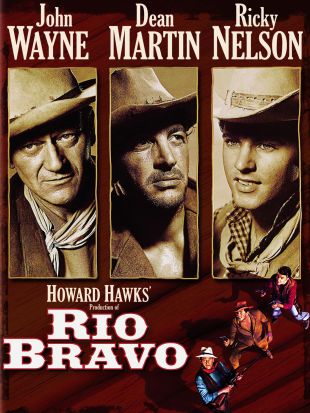
The inspiration behind Rio Bravo originated with the outrage that John Wayne and director/producer Howard Hawks both felt over the 1952 western High Noon -- neither man appreciated that earlier movie's depiction of the town marshal (played by Gary Cooper) and his desperate appeal to the townspeople for help against the band of outlaws headed their way. And so the two of them, in conjunction with screenwriters Leigh Brackett and Jules Furthman, set out to do a film in response, and the result was Rio Bravo, which was a complete inversion of High Noon in virtually every detail of its plot and structure. Both movies unfold in strictly linear fashion, but where High Noon takes place in real time, covering the life and death of a western town on a single morning in 85 minutes of screen time, Rio Bravo sets a surprisingly leisurely pace across nearly two and a half hours, telling a story spread across three days. Both movies utilize the services of composer Dimitri Tiomkin; but in contrast to High Noon's use of a central ballad that only the audience could hear, the centerpieces of Rio Bravo's score include a trumpet dirge that is very much in the consciousness of the characters; and the score also contains a pair of songs (one of them, "My Rifle, My Pony, And Me," adapted by Tiomkin from his own main title music for the 1948 Hawks/Wayne film Red River) sung by two of the characters. Finally, beyond its relationship to High Noon, Rio Bravo's most notable aesthetic attribute is its marvelously neat construction. As the opening credits roll, we see the wagons led by Pat Wheeler (Ward Bond) toward the Texas border town of Rio Bravo. Those wagons, as we later learn, contain dynamite, a cargo that will play an essential role in resolving the film's central plot conflict; and we glimpse Wheeler himself, whose friendship with Chance and whose offer of help will lead to his murder, an event that will drive the plot for the last two thirds of the movie, right through to the denouement. Rio Bravo was Bond's final film and it was a fitting send-off for Wayne's longtime friend -- his character is essential to the structure of the movie, introducing the town of Rio Bravo under the credits and providing the means by which Wayne can explain what is going on and why he and his deputies have to do this job alone. "Joe Burdette isn't worth one of those that would get killed," Chance tells Wheeler, who ends up the only man on the side of the law who is killed. The care with which Brackett and Furthman's screenplay lays out its material -- in what is essentially a moral, literary, and cinematic chess game -- is reflected throughout this "opening." Every key character and plot element is introduced within the first 30 minutes, along with the relationships that drive them, leading inexorably, move after move (not without some surprise twists) to the violent denouement. Rio Bravo was one of Wayne and Hawks's most successful and satisfying vehicles, which may help explain why they liked it so much and were so impressed with its potential for further exploration, that they remade it twice, once as El Dorado and once as Rio Lobo.
